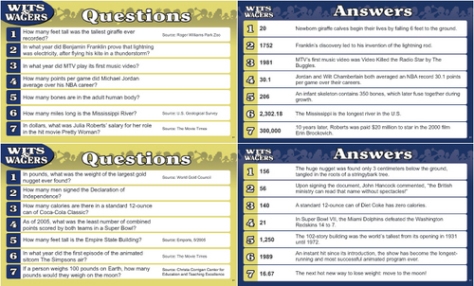Forbidden Island (Gamewright, 2010) just won the widely respected Mensa Select Seal, and I’m happy to say that it received my number one vote there (Mensa Select Seals are awarded annually at Mensa Mind Games, which was held in San Diego last weekend; go to my other blog at http://meeplespeak.wordpress.com/. for a description of the top five winners).
Forbidden Island is a cooperative game, so instead of players trying to outdo each other, they are working together to “beat the game.” Players compose a team of adventurers, racing against time to retrieve four treasures from a sinking island, and then escape before the water rises. If they escape with all four treasures, they have won.
Each player takes on a different role (Pilot, Engineer, Navigator, Messenger, Diver, or Adventurer), each having a special – but not outrageously powerful – ability, which aids in the three main tasks – getting around the island, “shoring up” the island (undoing the effects of rising water), and moving or claiming treasure. The island itself consists of tiles laid out randomly in a cross-shaped grid. Some tiles are labeled as places to claim treasure, and some are labeled with pawns, and serve as starting places for that player (pawn colors correspond to the identity and special ability of that player). There are six roles to choose from, but a maximum of four players results in the absence of at least two specialists.
Players alternate turns, performing three actions per turn, from this list: Move to an adjacent tile, Shore up a tile that has been flooded (i.e., unflood it), Give a treasure card to another player, or Claim a treasure. After the actions are taken, players draw two treasure cards – one of which might actually be one of three “Waters Rise” cards in the deck, but many of which represent one of the four treasures to be claimed. It takes four treasure cards to physically claim a treasure. When a “Waters Rise” card is chosen from the treasure deck, “Flood Cards” are drawn from a different deck. Each Flood Card represents one tile, thus revealing which tiles will be flooded. Those tiles are physically inverted, or, if they had already been inverted, they are removed from the game, along with their flood card. Yikes! As the game progresses, water levels only get higher…so more cards are drawn…thus more tiles flood when the Waters Rise cards are drawn. To make matters worse, when the Waters Rise cards is drawn, all the flood cards previously drawn are reshuffled and placed on top of the draw pile, so they are the first to be drawn again.
Forbidden Island is exciting to play. Your fate is bound to the fate of your colleagues, so each player has a stake in what the other players do. The bulk of the time is spent deciding, as a group, how to spend each of the three activities a player gets. In my first game we were literally one card away from being overtaken by the flood waters, and it was surprisingly simple to imagine ourselves on the rapidly disappearing island, trying to make it safely to the helicopter pad (“Fools’ Landing”).
For me, one very reliable sign of a good game is how easily immersed you are into its world, and Forbidden Island did that within two turns, and maintained it. It’s recommended for ages 10 and up, which is probably fair because one must really consider possible future problems and contingencies to win, but an 8 year old could enjoy the game with a little help. If you want to try something new for just a few people, give this game a shot!


























